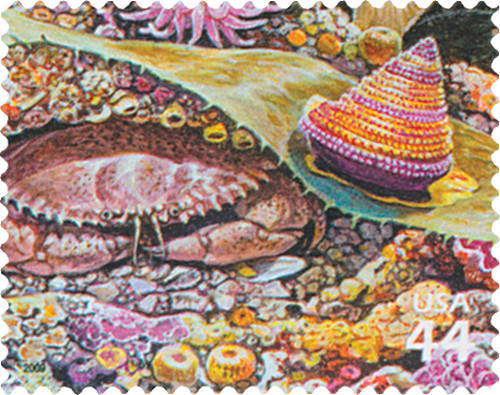
# 4423j - 2009 44c Kelp Forest: Treefish and Snail
Kelp Forest – Treefish
Nature of America
Issue Date: October 1, 2009
City: Monterey, CA
The treefish is highly territorial. When another treefish dares to swim into its territory, it raises its fins to display venomous spines. If this does not frighten off the intruder, the treefish will display its aggression by pushing out its fleshy pink lips.
Like other rockfish, the treefish lives at the bottom of the sea floor. Hunting at night, it relies on its yellow and black stripes for camouflage. Blending in with the forest of kelp, the treefish preys on unsuspecting fish, crab, and squid.
The treefish’s coloration also keeps it hidden from predators. Growing to a size of 10 to 14 inches, treefish have little hope of scaring off a 50-inch lingcod or 300-pound harbor seal. Hiding under rocks or crevices during the day, the treefish uses its color patterns to conceal itself in the nighttime kelp forest. These deceptive markings are vital to the treefish’s survival.
Being small does have its advantages. Its small size and solitary life keeps the treefish from being fished commercially. It is also passed up by fishermen who prefer to fish its much larger cousin, the vermilion rockfish.
The treefish has adapted well to life in the kelp forest. Lurking in the kelp beds, it can pounce on prey or hide from a predator.
Kelp Forest – Treefish
Nature of America
Issue Date: October 1, 2009
City: Monterey, CA
The treefish is highly territorial. When another treefish dares to swim into its territory, it raises its fins to display venomous spines. If this does not frighten off the intruder, the treefish will display its aggression by pushing out its fleshy pink lips.
Like other rockfish, the treefish lives at the bottom of the sea floor. Hunting at night, it relies on its yellow and black stripes for camouflage. Blending in with the forest of kelp, the treefish preys on unsuspecting fish, crab, and squid.
The treefish’s coloration also keeps it hidden from predators. Growing to a size of 10 to 14 inches, treefish have little hope of scaring off a 50-inch lingcod or 300-pound harbor seal. Hiding under rocks or crevices during the day, the treefish uses its color patterns to conceal itself in the nighttime kelp forest. These deceptive markings are vital to the treefish’s survival.
Being small does have its advantages. Its small size and solitary life keeps the treefish from being fished commercially. It is also passed up by fishermen who prefer to fish its much larger cousin, the vermilion rockfish.
The treefish has adapted well to life in the kelp forest. Lurking in the kelp beds, it can pounce on prey or hide from a predator.







